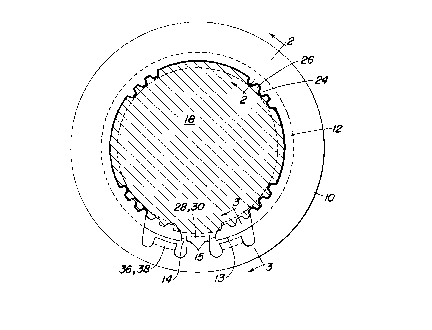Some of the information on this Web page has been provided by external sources. The Government of Canada is not responsible for the accuracy, reliability or currency of the information supplied by external sources. Users wishing to rely upon this information should consult directly with the source of the information. Content provided by external sources is not subject to official languages, privacy and accessibility requirements.
Any discrepancies in the text and image of the Claims and Abstract are due to differing posting times. Text of the Claims and Abstract are posted:
| (12) Patent: | (11) CA 2152843 |
|---|---|
| (54) English Title: | SNAP RING RETAINING WASHER |
| (54) French Title: | RONDELLE DE RETENUE DE BAGUE A RESSORT |
| Status: | Expired and beyond the Period of Reversal |
| (51) International Patent Classification (IPC): |
|
|---|---|
| (72) Inventors : |
|
| (73) Owners : |
|
| (71) Applicants : |
|
| (74) Agent: | BORDEN LADNER GERVAIS LLP |
| (74) Associate agent: | |
| (45) Issued: | 1998-11-24 |
| (22) Filed Date: | 1995-06-28 |
| (41) Open to Public Inspection: | 1996-01-13 |
| Examination requested: | 1995-06-28 |
| Availability of licence: | N/A |
| Dedicated to the Public: | N/A |
| (25) Language of filing: | English |
| Patent Cooperation Treaty (PCT): | No |
|---|
| (30) Application Priority Data: | ||||||
|---|---|---|---|---|---|---|
|
A washer includes at least one tooth interlocked with a
spline of a shaft in order to retain the washer from rotating
relative to the shaft. A snap ring is positioned in a groove
of the shaft. The washer includes a stop nested in a gap of
the snap ring in order to retain the snap ring from rotating
relative to the shaft. Preferably, the washer includes at
least one catch that flanks the stop and overlaps the snap
ring in order to retain the snap ring in the groove.
L'invention porte sur une rondelle comprenant au moins une dent interverrouillée avec une cannelure mâle d'une tige afin d'empêcher la rondelle de tourner relativement à la tige. Une bague à ressort est placée dans une rainure de la tige. La rondelle comporte une butée nichée dans un espace de la bague à ressort afin d'empêcher cette dernière de tourner par rapport à la tige. De préférence, la rondelle inclut au moins un crochet qui flanque la butée et chevauche la bague à ressort pour retenir cette dernière dans la rainure.
Note: Claims are shown in the official language in which they were submitted.
Note: Descriptions are shown in the official language in which they were submitted.

2024-08-01:As part of the Next Generation Patents (NGP) transition, the Canadian Patents Database (CPD) now contains a more detailed Event History, which replicates the Event Log of our new back-office solution.
Please note that "Inactive:" events refers to events no longer in use in our new back-office solution.
For a clearer understanding of the status of the application/patent presented on this page, the site Disclaimer , as well as the definitions for Patent , Event History , Maintenance Fee and Payment History should be consulted.
| Description | Date |
|---|---|
| Inactive: IPC from MCD | 2006-03-11 |
| Inactive: IPC from MCD | 2006-03-11 |
| Time Limit for Reversal Expired | 2002-06-28 |
| Letter Sent | 2001-06-28 |
| Grant by Issuance | 1998-11-24 |
| Inactive: Delete abandonment | 1998-08-13 |
| Deemed Abandoned - Conditions for Grant Determined Not Compliant | 1998-05-13 |
| Inactive: Final fee received | 1998-04-16 |
| Pre-grant | 1998-04-16 |
| Notice of Allowance is Issued | 1997-11-13 |
| Letter Sent | 1997-11-13 |
| Notice of Allowance is Issued | 1997-11-13 |
| Inactive: Status info is complete as of Log entry date | 1997-11-11 |
| Inactive: Application prosecuted on TS as of Log entry date | 1997-11-11 |
| Inactive: Approved for allowance (AFA) | 1997-09-11 |
| Application Published (Open to Public Inspection) | 1996-01-13 |
| Request for Examination Requirements Determined Compliant | 1995-06-28 |
| All Requirements for Examination Determined Compliant | 1995-06-28 |
| Abandonment Date | Reason | Reinstatement Date |
|---|---|---|
| 1998-05-13 |
The last payment was received on 1998-06-26
Note : If the full payment has not been received on or before the date indicated, a further fee may be required which may be one of the following
Please refer to the CIPO Patent Fees web page to see all current fee amounts.
| Fee Type | Anniversary Year | Due Date | Paid Date |
|---|---|---|---|
| MF (application, 2nd anniv.) - standard | 02 | 1997-06-30 | 1997-06-27 |
| Final fee - standard | 1998-04-16 | ||
| MF (application, 3rd anniv.) - standard | 03 | 1998-06-29 | 1998-06-26 |
| MF (patent, 4th anniv.) - standard | 1999-06-28 | 1999-06-25 | |
| MF (patent, 5th anniv.) - standard | 2000-06-28 | 2000-06-27 |
Note: Records showing the ownership history in alphabetical order.
| Current Owners on Record |
|---|
| DEERE & COMPANY |
| Past Owners on Record |
|---|
| DUANE FREDRICK MEYER |